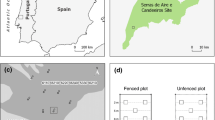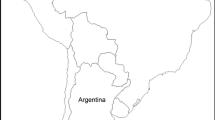Abstract
The study described changes in floristic and vegetation structure in relation to livestock grazing intensity in a conservation area in the Succulent Karoo, South Africa. Grazing by goats and sheep is allowed in the Richtersveld National Park (a contractual National Park. which is also an area of high floristic richness and endemism. We used goat faecal pellet density, degree of trampling and percentage bare-ground at distances from the stock posts as surrogates for a gradient in grazing pressure. A stock post is the place where farmers keep, in most cases in an enclosure called a ‘kraal’, their animals at night and to which they return every evening after the day’s herding. Twenty-seven stock posts were located in the Richtersveld National Park; nine stock posts on flats, foot– slopes and mountain each. We measured plant species richness and diversity, and mean percentage cover of the various plant growth forms (including the number of species falling into each growth form category. in each of the five 10 m . 10 m plots (each 200 m apart. demarcated along a transect of one kilometre length from the centre of each stock post. The results showed that distance from the stock post does reflect grazing intensity use because densities in faecal pellets rapidly declined with increasing distances away from the stock post for all habitats studied. Faecal density was positively correlated with stocking density. Plant species richness and diversity was at a minimum near stock posts. Plants able to endure the effects of heavy grazing occurred near stock posts where declines in palatable plant species, assumingly sensitive to heavy grazing and trampling, were recorded. Grazing increased vegetation patchiness up to 800 m from the stock post for all the habitats. The degree to which this change in species composition occurred did not depend on stocking densities, suggesting that both grazing and landscape variability were responsible for vegetation changes in rangelands of that area of the Succulent Karoo biome.
Similar content being viewed by others
References
D.L. Barnes (1976) ArticleTitleA review of plant–based methods for estimating food consumption, percentage utilization, species preferences and feeding patterns of grazing and browsing animals Proceedings of the Grassland Society of Southern Africa 11 65–71
G.N. Bastin G. Pickup V.H. Chewings G. Pearce (1993a) ArticleTitleLand degradation assessment in central Australia using a grazing gradient method Rangeland Journal 15 IssueID3 190–216
G.N. Bastin A.D. Sparrow G. Pearce (1993b) ArticleTitleGrazing gradients in central Australian rangelands: ground verification of remote sensing–based approach Rangeland Journal. 15 IssueID2 217–233
W.J. Bond (1999) Rangelands and biodiversity in southern Africa – impacts of contrasting management systems.. In: Eldridge D D. Freundenberger (Eds) People and Rangelands: buiding the future. Proceedings of the VI International Rangeland Congress Queensland Australia
W.J. Bond P.G. Ladd (2001) ArticleTitleDynamics of the overstorey and species richness in Australian heathlands Journal of Mediterranean Ecology 2 247–257
C. Bromilow (1995) Problem plants of South Africa Briza Publications Pretoria, South Africa
S.L. Collins (1992) ArticleTitleHeterogeneity of disturbed tallgrass prairie communities Ecology 73 2001–2006
R.T. Coupland (1992) Mixed prairie: ecosystems of the world R.T. Coupland (Eds) Natural grasslands: introduction and Western Hemisphere Elsevier New York, USA 151–182
R.M. Cowling K.J. Esler P.W. Rundel (1999) ArticleTitleNamaqualand, South Africa –an overview of a unique winter–rainfall desert ecosystem Plant Ecology 142 3–21 Occurrence Handle10.1023/A:1009831308074
R.M. Cowling G.E. Gibbs Russel M.T. Hoffman C. Hilton–Tay–lor (1989) Patterns of plant species diversity in southern Africa.. In: Huntley B B.J. Huntley (Eds) Biotic diversity in Southern Africa Oxford University Press Cape Town, South Africa 19–50
R.M. Cowling C. Hilton–Taylor (1994) ArticleTitlePatterns of plant diversity and endemism in southern Africa: an overview Strelitzia 1 31–52
R.M. Cowling S.M. Pierce (1999) Namaqualand: a succulent desert Fernwood Press Vlaeberg, South Africa
W.A.H. Ellis B.J. Sullivan A.T. Lisle F.N. Carrick (1998) ArticleTitleSpatial and temporal distribution of koala faecal pellets Wildlife Research. 25 663–668 Occurrence Handle10.1071/WR97028
K.J. Esler P.W. Rundel (1999) ArticleTitleComparative patterns of phenology and growth from diversity in two winter rainfall deserts: the Succulent Karoo and Mojave Desert ecosystems Plant Ecology 142 97–104 Occurrence Handle10.1023/A:1009830513525
K.J. Esler P.W. Rundel R.M. Cowling (1999) The Succulent Karoo in a global context: plant structural and functional comparison with North American winter rainfall deserts W.R.J. Dean S.J. Milton (Eds) The Karoo: Ecological patterns and processes Cambridge University Press United Kingdom 257–273
B.D. Foran G.N. Bastin K.A. Shaw (1986) ArticleTitleRange assessment and monitoring in arid lands: the use of classification and ordination in range survey Journal of Environmental Management 22 67–84
R.D. Graetz J.A. Ludwig (1978) ArticleTitleA method for the analysis of piophere data applicable to range assessment Australian Rangeland Journal. 1 126–136
H.H. Hendricks (1998) ArticleTitleTraditional stock farming in the Richtersveld Veld and Flora 84 IssueID3 86–87
H.H. Hendricks P.A. Novellie J.J. Midgley (2002) ArticleTitleDiet selection of goats in the Richtersveld National Park African Journal of Range and Forage Science. 19 IssueID1 1–11
Hendricks H.H., Bond W.J., Migley J.J. and Novellie P.A. 2003. On the move – mitigating the effect of rainfall variability on livestock production. African Journal of Range and Forage Science (submitted).
C. Hilton–Taylor (1996) Patterns and characteristics of the flora of the Succulent Karoo Biome, southern Africa L.J.E. Maesen Particlevan der X.M. Burgt Particlevan der J.M. Medenbachde Rooy (Eds) The biodiversity of African plants Kluwer Academic Publishers Dordrecht, The Netherlands 58–72
M.T. Hoffman (1989) ArticleTitleA preliminary investigation of the phenology of subtropical thicket and karroid shrublands in the lower Sundays River Valley, SE Cape South African Journal of Botany 55 IssueID6 586–597
MT Hoffman B Cousins T Meyer A Petersen HH. Hendricks (1999) Historical and contemporary land use and the desertification of the karoo W.R.J. Dean S.J. Milton (Eds) The Karoo: Ecological patterns and processes Cambridge University Press United Kingdom 257–273
B.J. Huntley (1989) Biotic diversity in Southern Africa Oxford University Press Cape Town, South Africa
C. James M. Stafford Smith J. Bosma J. Landsberg R. Tynan J. Maconochie (1999) Production, persistence, economic and extinction: integrating conservation and pastoralism in Australian rangelands.. In: Eldridge F D. Freudenberger (Eds) People and Rangelands: building the future Proceedings of the VI International Rangeland Congress Queensland, Australia
N. Jürgens I.H. Gotzmann R.M. Cowling (1999) ArticleTitleRemarkable medium–term dynamics of leaf succulent Mesembryanthemaceae shrubs in the winter–rainfall desert of northwestern Namaqualand, South Africa Plant Ecology. 142 87–96 Occurrence Handle10.1023/A:1009862025821
InstitutionalAuthorNameLand Type Survey Staff (1987) Land types of the maps Alexander Bay 2816, 2818 Warmbad, 2916 Springbok, 2918 Pofadder, 3017 Garies, 3018 Loeriefontein Memoir of Agriculture and Natural Resource of South Africa Pretoria, South Africa
R.T. Lange (1969) ArticleTitleThe piosphere: sheep track and dung patterns Journal of Range Management 22 396–400
J. Landsberg C.D. James S. Morton T.J. Hobbs J. Stol A. Drew H. Tongway (1997) The effects of artificial sources of water on rangeland biodiversity. Final report to the Biodiversity Convention and Strategy Section of the Biodiversity Group, Environment Australia CSIRO Canberra
D.G. Milchunas W.K. Lauenroth (1993) ArticleTitleQuantitative effects of grazing on vegetation and soils over a global range of environments Ecological Monographs. 63 327–366
S.J. Milton (1991) ArticleTitlePlant spinescence in arid southern Africa: does moisture mediate selection by mammals? Oecologia 87 279–287 Occurrence Handle10.1007/BF00325267
S.J. Milton W.R.J. Dean J. Settele D. Vetterlein (1998) Effects of physical refuges and human activities on plant population dynamics and bird assemblages in the Richtersveld National Park Pp8. Unpublished technical report, Scientific Services South African National Parks Kimberley
S.J. Milton M.T. Hoffman (1994) ArticleTitleThe application of state–and–transition models to arid rangeland research and management in arid succulent and semi–arid grassy Karoo, South Africa African Journal of Range and Forage Science 11 18–26
S.J. Milton R.I. Yeaton W.R.J. Dean J.H.J. Vlok (1997) Succulent Karoopp R.M. Cowling D.M. Richardson S.M. Pierce (Eds) The vegetation of Southern Africa Cambridge University Press Cambridge, UK 131–166
T.G. O’Connor P.W. Roux (1995) ArticleTitleVegetation changes (1949–71. in a semi–arid, grassy dwarf shrubland in the Karoo, South Africa: influence of rainfall variability and grazing by sheep Journal of Applied Ecology 32 612–626
J. Oskanen (1996) ArticleTitleIs the hump relationship between species richness and biomass an artifact due to plot size? Journal of Ecology 84 293–295
N. Owen–Smith (1999) The animal factor in veld management N.M. Tainton (Eds) Veld management in South Africa (ed N.M..) Second edition University of Natal Press Pietermaritzburg South Africa 117–138
R.K. Peet (1974) ArticleTitleThe measurement of species diversity Annual Review of Ecology and Systematics. 5 285–307 Occurrence Handle10.1146/annurev.es.05.110174.001441
G. Pickup (1989) ArticleTitleNew land degradation survey techniques for arid Australia: problems and prospects Australian Rangeland Journa. 11 74–82
M.E. Ritchie H. Olff (1999) Herbivore diversity and plant dynamics: compensatory and additive effects H. Olff V.K. Brown R.T. Drent (Eds) Herbivores: between plants and predators Blackwell Science London, UK 175–204
B. Rossa D.J. Willert Particlevon (1999) ArticleTitlePhysiological characteristics of geophytes in semiarid Namaqualand, South Africa Plant Ecology 142 121–132 Occurrence Handle10.1023/A:1009870227638
P.W. Roux M. Vorster (1983) ArticleTitleVegetation change in the Karoo Proceedings of the Grassland Society of Southern Africa 18 18–24
M.C. Rutherford R.M. Westfall (1986) ArticleTitleBiomes of southern Africa – an objective categorization Memoirs of the Botanical Survey of South Africa 54 1–98
D.W. Schwilk J.E. Keeley W.J. Bond (1997) ArticleTitleThe intermediate disturbance hypothesis does not explain fire and diversity patterns in fynbos Plant Ecology 132 77–84 Occurrence Handle10.1023/A:1009755320731
MHH Stevens WP Carson (1999) ArticleTitlePlant density determines species richness along an experimental fertility gradient Ecology 80 IssueID2 455–465
Stokes C.J. 1994. Degradation and dynamics of Succulent Karoo vegetation. MSc. thesis. University of Natal, South Africa.
L.W. Swift (1976) ArticleTitleAlgorithm for solar radiation on mountain slopes Water Resources Research. 12 108–112
N.M. Tainton (1981) The ecology of the main grazing lands of South Africa: production characteristics of the main grazing lands N. Tainton (Eds) Veld and Pasture Management in South Africa Shuter and Shooter in association with Natal University Press Pietermaritzburg, South Africa 25–56
N.M. Tainton (1999) The ecology of the main grazing lands of South Africa N.M. tainton (Eds) Veld management in South Africa. Second edition University of Natal Press Pietermaritzburg, South Africa 23–53
S. Todd M.T. Hoffman (1999) ArticleTitleEffects of heavy grazing on plant species diversity and community composition in a communally managed semi–arid shrubland, Namaqualand, South Africa Plant Ecology 142 169–178 Occurrence Handle10.1023/A:1009810008982
R. Tynan J. Maconochie C. James J. Landsberg D. Tongway (1999) Grazing gradients, biodiversity and landscape function in Australian rangelands D. Eldridge D. Freudenberger (Eds) People and Rangelands: building the future Proceedings of the VI International Rangeland Congress Queensland, Australia
F. Vander Heyden W.D. Stock (1999) The response of forage plants to defoliation: karoo shrubs N.M. Tainton (Eds) Veld management in South Africa. Second edition University of Natal Press Pietermaritzburg South Africa 103–109
N. Rooyen Particlevan D.J. Rensburg G.K. Theron P. Bothma Du (1990) ArticleTitleMonitoring of the vegetation around artificial watering points (windmills) in the Kalahari Gemsbok National Park Koedoe 33 63–88
D.J. Willert Particlevon B.M. Eller M.J.A. Werger E. Brinckmann H.–D. Ihenfeldt (1992) Life strategies of succulents in deserts: with special reference to the Namib Desert Cambridge University Press Cambridge UK
M.J.A. Werger R.P. Ellis (1981) ArticleTitlePhotosynthetic pathways in the arid regions of South Africa Flora 171 64–75
M. Westoby (1980) ArticleTitleElements of a theory of vegetation dynamics in arid rangelands Israel Journal of Botany 28 169–194
R.H. Whittaker (1980) Classification of plant communities Dr W. Junk bv Publishers The Hague, London, UK.
T. Wiegand S.J. Milton (1996) ArticleTitleVegetation change in semi–arid communities Vegetatio 125 169–183 Occurrence Handle10.1007/BF00044649
A.D. Wilson (1986) The monitoring of changes in range condition: a multivariate site potential approach In: Rangelands: a resource under siege Proceedings of the IX International Rangeland Congress, Australian Academy of Science Canberra, Australia 517–521
RI Yeaton KJ. Esler (1990) ArticleTitleThe dynamics of succulent karoo vegetation:a study of species association and recruitment Vegetatio 88 103–113 Occurrence Handle10.1007/BF00044827
J.H. Zar (1984) Biostatistical Analysis Prentice–Hall. New Jersey USA
Author information
Authors and Affiliations
Rights and permissions
About this article
Cite this article
Hendricks, H.H., Bond, W.J., Midgley, J.J. et al. Plant species richness and composition a long livestock grazing intensity gradients in a Namaqualand (South Africa) protected area. Plant Ecol 176, 19–33 (2005). https://doi.org/10.1007/s11258-003-0009-6
Received:
Accepted:
Issue Date:
DOI: https://doi.org/10.1007/s11258-003-0009-6




